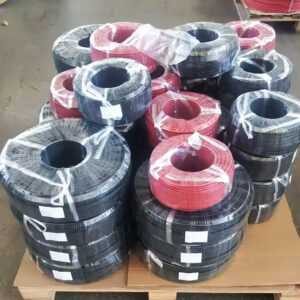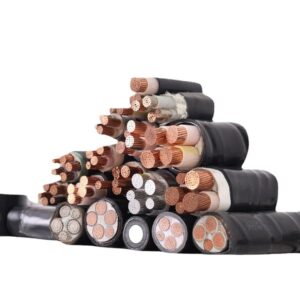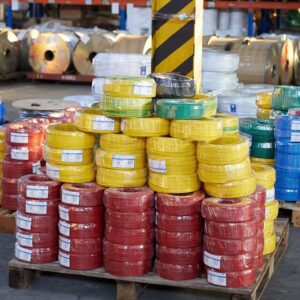

Selecting the correct solar cable size is critical for the efficiency, safety, and longevity of your 10kW solar system. Undersized cables can cause overheating, energy loss, and fire hazards, while oversized cables add unnecessary costs. This guide breaks down key factors—voltage, current, distance, and environmental conditions—to help you make an informed decision. 1. Why Solar Cable Size Matters Solar cables connect panels, inverters, and the grid, carrying DC and AC power. Key risks of incorrect sizing: 2. Key Factors Determining Cable Size A. System Specifications B. Voltage Drop Limit voltage drop to <3% for efficiency. Use the formula: text Cable Size (mm²) = (2 × Distance × Current) / (Voltage Drop × Conductivity) Note: C.

As a professional welding cable manufacturer, yh cable understands that reliable welding cable is the lifeline of safe operations. Ordinary cables crack under high heat, causing downtime and hazards. This guide breaks down 5 critical selection factors based on industrial standards. 1. Insulation Material: Your First Defense Standard PVC insulation hardens at 60°C (140°F), while welding arcs exceed 100°C (212°F). Opt for: 2. Conductor Flexibility: Critical for Maneuverability Flexibility Grade Conductor Structure Best For Standard Class 5 stranding Fixed stations High Flex Class 6 ultra-fine strands Manual torches Super Flex >1000 strands Robotic arms Fine-stranded oxygen-free copper reduces fatigue fractures by 70% (Lincoln Electric tests). 3. Ampacity & Size: Avoid Overheating Undersized cables cause

Introduction Choosing between PV cable and standard cable for solar installations isn’t just about cost – it’s a critical decision impacting system safety, efficiency, and longevity. While standard cables may seem interchangeable, they lack specialized engineering to withstand photovoltaic environments. This guide breaks down the technical differences backed by international standards, explaining why PV cables are non-negotiable for solar projects. 5 Key Differences (With Visual Aids) 1. Material Construction Component PV Cable Standard Cable Insulation Cross-linked Polyolefin (XLPO) PVC or Thermoplastic Conductor Tinned copper (anti-oxidation) Bare copper Jacket Double-layer: UV-resistant + hydrolysis-proof Single-layer PVC 2. Environmental Resistance UV Stability Temperature Range PV Cable Standard Cable Operating Range -40°C to 120°C -20°C to

High temperature resistant cable is non-negotiable for industrial park power system upgrades – where extreme heat from machinery, processes, or ambient conditions can melt standard cables, causing fires and costly downtime. Selecting the wrong cable risks safety violations, operational failures, and 40% higher replacement costs. This guide breaks down how to choose industrial-grade heat-resistant cables that meet regulatory demands while maximizing ROI. 1. Temperature Class: Match Cable to Thermal Zones Industrial environments have distinct heat zones: Area Temp Range Cable Type Boiler Rooms 90°C–150°C Silicone Rubber (RGG) Steel Mills 150°C–250°C Mineral Insulated (MICC) Tunnels/Utilities 60°C–90°C XLPE/LSZH Outdoor High-Ambient 50°C–70°C UV-Resistant XLPE Pro Tip: Add 20°C margin above measured peak temperatures. 2. Material

Introduction: Understanding NYY Cable NYY cable is a heavy-duty power cable designed for fixed installations in demanding environments. With robust PVC insulation, copper conductors, and weather-resistant sheathing, it meets international standards like IEC 60502 for reliable power distribution. Core Structure & Key Properties Illustration: Multi-core copper conductors with PVC insulation + black PVC outer sheath. Top 5 Applications of NYY Cable 1. Underground Power Distribution NYY’s moisture-proof sheath makes it ideal for direct burial in: 2. Industrial Control Systems Used in: 3. Renewable Energy Projects Deployed in: 4. Infrastructure & Public Works Common in: 5. Marine & Coastal Installations Saltwater-resistant variants (NYY-O) for: NYY vs. Similar Cables: When to Choose NYY? Scenario Recommended Cable Why NYY

Solar cable quality directly impacts your photovoltaic system’s safety, efficiency, and lifespan – but not all products meet the rigorous demands of solar applications. While they may appear similar, critical differences in materials, certifications, and design determine whether a cable delivers 25+ years of reliable service or becomes a liability. In this guide, we’ll break down how solar panel cables vary and what specifications truly matter for your PV installation. 1. Conductor Material: Copper vs. Tinned Copper ✔ Standard Solar Cable ✔ Premium Solar Cable (e.g., H1Z2Z2-K) Conclusion: Choose Based on Application While all solar cables serve the same purpose, their performance varies dramatically. Match your selection to:✅ Environment (coastal? desert?)✅ System Voltage (600V/1500V)✅ Certification Needs (TIV mandatory in EU) Need

© All Rights Reserved.